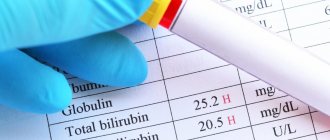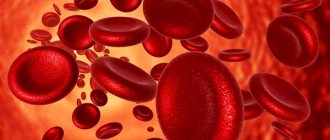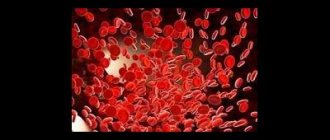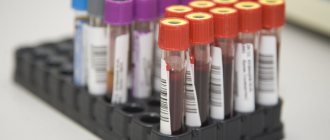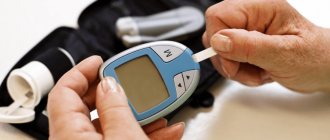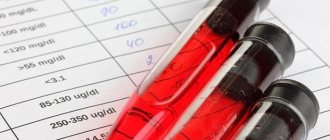Bilirubin is the main component of bile, has a yellow-brown color, and is formed as a result of the breakdown of hemoglobin. Cleavage occurs in the bone marrow, liver, and lymph nodes.
The bulk of bilirubin is found in the liver and gallbladder; a small amount is constantly present in the blood. This allows you to determine its level in a blood test, and based on this, make a diagnosis.
Deviation of indicators from the norm in any direction can be a pathology, so this must be taken seriously. Consider the case of low bilirubin levels in the blood.
In this article you will find all the information you are interested in about why total bilirubin is low in an adult, what this means, what are the reasons and methods for increasing it.
Detailed description of the study
The liver is an organ in which complex metabolic processes occur. The functional activity of the liver is provided by hepatocyte cells, they are responsible for:
- Bilirubin exchange and bile formation;
- Regulation of carbohydrate metabolism;
- Regulation of fat metabolism;
- Formation of many proteins, including enzymes;
- Neutralization of toxic substances (medicines, alcohol, etc.).
Bilirubin is an orange-yellow pigment formed during the breakdown of heme (a component of hemoglobin). Every day, the human body synthesizes about 350 mg of indirect (free) bilirubin. Most of it is formed during the breakdown of red blood cells, a smaller part (about 20%) is formed from other heme proteins in the liver and bone marrow.
Free bilirubin is insoluble in water; it is transported in human blood plasma in combination with a protein - albumin. Next, the liver captures free bilirubin, and after a series of transformations it is converted into direct (associated with glucoronic acid) bilirubin, which is soluble in water.
Bound bilirubin in bile is sent to the gallbladder and released into the small intestine during food digestion. In the small intestine it is metabolized by bacteria to urobilinogen. Most of the urobilinogen is transformed into stercobilin, which turns the stool brown. A small amount of urobilinogen is reabsorbed by the liver and returns to the bile. A small part is excreted in the urine.
Normally, the level of indirect bilirubin in the blood is very low. If the concentration of bilirubin and its fractions increases, a person may develop yellowness of the skin and whites of the eyes. This condition is called jaundice.
Depending on the cause of bilirubin metabolism disorders, there are three types of jaundice:
- Hemolytic;
- Parenchymatous;
- Mechanical.
1) Hemolytic, or suprahepatic, jaundice is associated with increased release of bilirubin into the blood due to increased breakdown of red blood cells. The pigment formed during destruction is not captured by hepatocytes, but remains in the blood (having a toxic effect). A similar pathology can be observed in newborns when their Rh factor is incompatible with that of the mother (Rh conflict).
In rare cases, a congenital disorder of bilirubin metabolism known as Gilbert's syndrome occurs. This disorder is associated with reduced activity of the enzyme glucuronyl transferase, which converts indirect bilirubin into direct bilirubin. As a rule, it is determined by chance and has a favorable clinical course.
Hereditary diseases associated with defects in the functioning of enzymes responsible for bilirubin metabolism also include Dubin-Johnson syndrome and Rotor syndrome.
Increased release of indirect bilirubin into the blood accompanies hemolytic anemia. This condition is also associated with the premature breakdown of red blood cells and the inability to fully metabolize this pigment in liver cells due to its excess.
May be caused by internal defects in the red blood cells themselves (hereditary pathology) or:
- Taking certain medications (methyldopa, penicillin, quinine, etc.);
- Immunological disorders;
- Infections;
- Mechanical damage to blood vessels;
- Toxic effects (copper, lead).
2) Hepatic, or parenchymal, jaundice occurs due to lesions of the liver tissue. Such conditions are diagnosed with viral hepatitis, poisoning, sepsis, etc.
3) Mechanical, or subhepatic, (obstructive) jaundice occurs due to the presence of mechanical obstacles (stones, tumors) in the bile ducts, which impairs the outflow (excretion) of bile.
A bilirubin test may be used as part of an annual physical to evaluate liver health. It is also used to determine the causes of jaundice and helps the specialist determine the tactics of further therapy.
The study is also carried out in newborns with jaundice to determine its causes.
Normal bilirubin level in blood
Modern diagnosis of diseases is impossible without a biochemical blood test. An important indicator in this analysis is the level of total bilirubin.
In blood serum, degraded bilirubin is contained in 2 fractions:
- Indirect - it is also called pure or free, it makes up 75% of the total amount. It is toxic to the body, insoluble in water, you can get rid of this fraction if it becomes water-soluble;
- Direct (bound) – makes up 25%, binds to water, becomes soluble in it, and therefore is easily excreted in feces and urine.
The total amount of both types adds up to the concentration of total bilirubin in the blood. Its norm is 3.4-17.1 µmol/liter.
An increase in total bilirubin above 20.1 µmol/liter is dangerous: the body begins to experience toxic poisoning.
The normal blood level is the same for everyone, regardless of gender and age. The only exception is newborn children; their values coincide with adult values approximately at the end of the 3rd week of life.
References
- Clinical guidelines “Drug-induced liver damage”, 2019. - 35 p.
- Pakhomova, R.A., Kochetova, L.V. Clinical manifestations of obstructive jaundice and liver failure, depending on the severity of obstructive jaundice of benign origin.” — Modern problems of science and education, 2021. — No. 6. — P.47.
- Sullivan, J., Rockey., D. Diagnosis and evaluation of hyperbilirubinemia. — Current opinion in gastroenterology, 2021. — Vol. 33(3). — P. 164-170.
Causes of low total bilirubin
Increased bilirubin is more common. Reduced bilirubin is less common and can indicate serious pathological changes in the body. Let's find out the reasons that lead to a decrease in blood levels.
A decrease in the amount of total bilirubin fractions occurs in the following conditions:
- For chronic renal failure;
- In acute forms of blood cancer (leukemia) and tuberculosis;
- For aplastic anemia.
Reduced bilirubin may appear if the preparation for the test is improper; in this case, it is recommended to donate blood again.
Kidney failure
Another cause of low bilirubin in the blood is kidney failure. Inflammatory diseases (glomerulonephritis, pyelonephritis) lead to chronic kidney failure.
Kidneys can also be affected by:
- Narrowing (stenosis) of the renal arteries;
- Hormonal disorders (diabetes mellitus);
- Urolithiasis disease;
- Chronic increase in blood pressure (arterial hypertension);
- Lupus erythematosus.
The disease begins to manifest itself when the kidney tissue capable of functioning is reduced by 70%. At the same time, the level of creatinine and urea in the blood increases, and the glomerular filtration rate decreases. If the rate is less than 10 ml/min, hemodialysis (artificial kidney) is necessary.
Acute form of leukemia and tuberculosis
There are various forms of blood leukemia (the name “blood cancer” is common to all leukemias). In this case, the process of cell division is disrupted, and damaged cells replace healthy ones. With a lack of various components and types of cells, leukemia occurs, which can be acute or chronic.
Patients with acute leukemia often experience anemic syndrome, in which the hemoglobin level can drop to 20 g/l, and the erythrocyte content is up to 1.0 * 1012/liter.
Anemia may worsen depending on the stage of the disease.
If the presence of tuberculosis bacillus in the body is suspected, a biochemical blood test is also prescribed. It detects an increase in urea and creatinine levels, which can lead to impaired kidney function. Tuberculosis intoxication also leads to a decrease in the level of total bilirubin.
Aplastic anemia
This is a disease of the hematopoietic system, in which the maturation and growth of blood cells - platelets and red blood cells - stops in the bone marrow. The disease develops slowly, patients live for years, experiencing drowsiness and dizziness. Patients turn to doctors when the process has gone too far.
With thrombocytopenia (decreased platelets), bruising and bluish rashes on the skin occur. Patients are concerned about nasal, dental and uterine bleeding. Sometimes hemorrhages and bruises fester, and there is a risk of infection.
Anemia in such patients is associated not only with insufficient formation of blood cells, but also with prolonged bleeding.
Incorrect preparation for analysis
Reduced total bilirubin in the blood can be a consequence of serious diseases. But very often there are situations when the patient has not properly prepared for a biochemical study.
Some people have skewed total bilirubin levels due to elevated levels of caffeine or ascorbic acid, so avoid strong coffee drinks and citrus fruits before donating blood.
Erroneously low bilirubin may occur after taking the following substances:
- Choleretic drugs;
- Means to support liver function;
- Heparin;
- Aspirin;
- Phenobarbital;
- Warfavin;
- Theophylline.
Diets or complete fasting also lead to incorrect results.
Distorted bilirubin levels (low or high) in a blood test are possible due to the human factor. The presence of a medical error cannot be ruled out either.
Increased bilirubin
A person with a reduced value of both fractions should stop drinking alcoholic beverages to establish an accurate diagnosis.
Reduced bilirubin can be treated by adjusting the diet, as well as by increasing the physical activity of the body.
Increasing physical activity, swimming, jogging, and cycling help get rid of stagnant bile in the body. Eating a healthy diet can also solve the problem, especially in pregnant women.
Reasons for decreased direct and indirect bilirubin
Any non-compliance with performance standards should raise concerns. There should also be no exceptions regarding the concentration of bilirubin. Therefore, if one of the types of bilirubin in the blood - direct or indirect - is reduced, you should find out what this means, what are the causes and consequences of such changes for the body and human life as a whole. A significant reduction in various fractions of the substance is also of great clinical significance.
Direct bilirubin is reduced
Direct, or bound, bilirubin is formed in the liver as a result of the combination of free bilirubin with glucuronic acid. Having turned into a water-soluble fraction, it can freely leave the body along with feces and urine.
The normal level of direct bilirubin in an adult is 3.4-5.1 µmol/l.
The reasons for the decrease in the direct indicator are:
- Consumption of alcoholic beverages;
- Taking glucocorticosteroids (prednisolone);
- Treatment with antibiotics (penicillin);
- Ascorbic acid and Phenobarbital.
Indirect lowered
Indirect, free or pure bilirubin cannot be removed directly from the body. It is poisonous to humans; the lower its content in the blood serum, the better.
The normal level of indirect bilirubin in an adult is 3.4-12.0 µmol/l.
The free fraction may decrease:
- During pregnancy, increased load on the kidneys due to edema and changes in blood pressure can cause such a decrease;
- In children - in newborns, the indicator changes literally by day of life. A decrease in the amount of the indirect component may indicate the presence of renal failure.
Today, a reduced level of direct or indirect bilirubin indicates the general condition of a person and has not yet been fully studied.
Preparing for the test
A biochemical blood test requires special preparation, otherwise the result may be distorted and lead to an incorrect diagnosis.
For the following diseases, it is necessary to study the level of bilirubin:
- For cirrhosis and hepatitis to determine liver function;
- For hemolytic disease;
- To identify jaundice of various etiologies;
- For diseases of the gallbladder, to determine the patency of the bile ducts and the presence of stones;
- In case of toxic or alcohol poisoning;
- When taking large doses of drugs that affect the liver;
- If you suspect liver cancer.
To obtain a reliable analysis, blood is taken on an empty stomach; the last meal should be no later than 12 hours before the test. Blood is drawn from a vein in an amount of 5 ml. The result is ready on the same day in a few hours.
